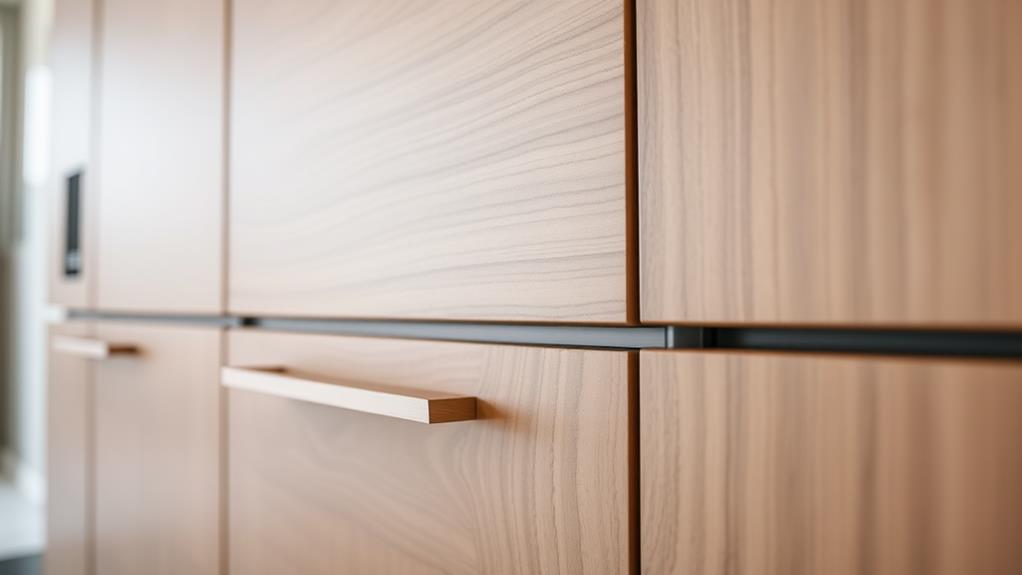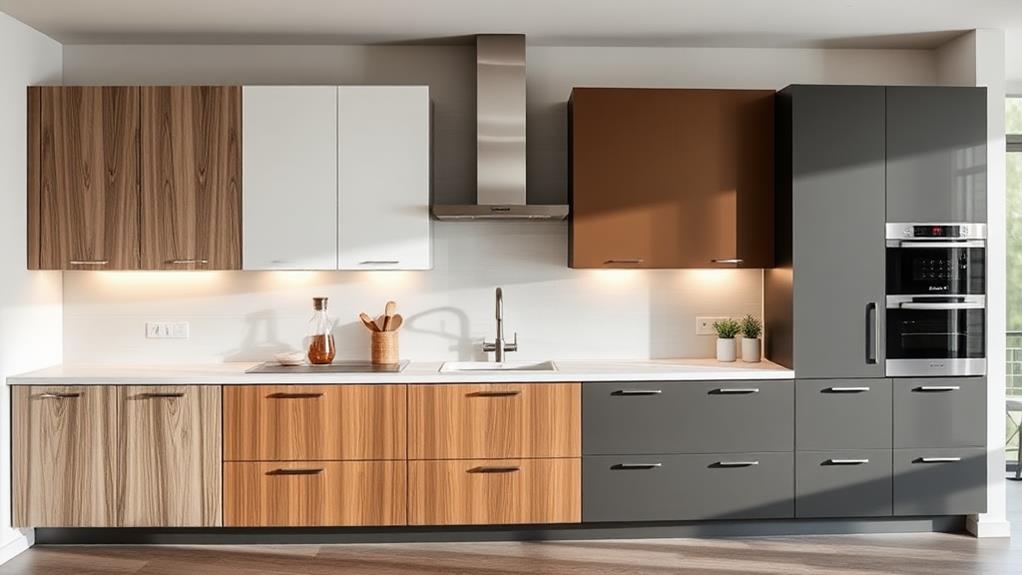What Are Frameless Kitchen Cabinets
Frameless kitchen cabinets, also called European-style cabinets, are a modern alternative to traditional framed cabinetry. You'll notice they lack a front face frame, offering full access to the cabinet interior and maximizing storage space. These cabinets feature thicker side panels for stability and use edge banding for a sleek finish. They're constructed using engineered wood materials and follow a 32-mm system for easy hardware installation. Frameless cabinets provide a contemporary look, increased drawer capacity, and simplified cleaning due to fewer crevices. While they require precise measurements for installation, they offer numerous customization options for door styles, finishes, and interior organization. Exploring further will reveal additional benefits and design possibilities.
This post may contain affiliate links. If you make a purchase through these links, I may earn a commission at no additional cost to you. Additionally, portions of this post may be generated using artificial intelligence (AI) technology. While we strive for accuracy, please be aware that AI-generated content may not always be perfect and should be fact-checked when necessary.
The Spatula Scoops
- Frameless kitchen cabinets lack a front face frame, providing full access to cabinet interiors.
- They feature thicker side panels (typically 3/4 inch) for enhanced stability and durability.
- These cabinets use European-style hinges and follow a 32-mm system for hardware installation.
- Frameless designs offer a sleek, contemporary appearance with maximized storage space.
- They are constructed using engineered wood materials and finished with protective edge banding.
Understanding Frameless Cabinet Design

Frameless kitchen cabinets are revolutionizing modern kitchen design. You'll find these European-style cabinets offer a sleek, contemporary look that maximizes your storage space. Unlike traditional cabinets, frameless designs don't have a front face frame, allowing for full access to the interior. This means you can easily store larger items and make the most of every inch.
The construction of frameless cabinets is unique. They're built with thicker side panels, which provide enhanced stability and durability. You'll also notice that the visible edges are finished with edge banding, giving them a polished appearance while improving their longevity. These cabinets follow a 32-mm system for hardware placement, making it simple to install doors, drawers, and shelves.
When you choose frameless cabinets, you're opting for a design that prioritizes both form and function. The absence of center stiles not only contributes to their modern aesthetics but also improves usability. You'll appreciate the clean lines and unobstructed access to your kitchen essentials. Whether you're remodeling or building a new kitchen, frameless cabinets offer a practical and stylish solution that aligns with contemporary design trends.
Benefits of Frameless Cabinetry
Efficiency and aesthetics combine seamlessly in the benefits of frameless cabinetry. When you choose full access cabinets, you'll maximize your storage space and easily fit larger items inside. The modern look of frameless designs enhances contemporary kitchen aesthetics, providing a sleek appearance without the face frame.
One of the most significant advantages is the increased drawer box capacity. You'll have more room to store your kitchen essentials, making organization a breeze. Additionally, the factory-finished sides guarantee a polished appearance throughout, reducing the need for extra finishing work during installation.
| Feature | Benefit | Impact |
|---|---|---|
| Full access | Maximized storage | Easier organization |
| Modern design | Sleek appearance | Enhanced aesthetics |
| Larger drawer boxes | Increased capacity | More storage options |
Cleaning and maintenance are simplified with frameless cabinetry. The streamlined design means fewer crevices and edges where dust can accumulate, making it easier to keep your kitchen looking spotless. You'll appreciate the structural support provided by the cabinet's construction, assuring durability without compromising on style. With frameless cabinetry, you're investing in a functional and visually appealing solution for your contemporary kitchen.
Construction Techniques and Materials

The foundation of frameless cabinetry's benefits lies in its unique construction techniques and materials. When you choose frameless cabinets, you're opting for a design that relies on thicker side panels, typically 3/4 inch, to provide stability and maximize interior space. These cabinets are built using engineered wood materials like particle board, plywood, or MDF, which contribute to durable designs that can withstand daily use.
The assembly process of frameless construction often involves dowels and glue to connect components, ensuring a robust structure. You'll find that edgebanding is applied to visible surfaces, not only enhancing the aesthetic appeal but also protecting against wear and tear. One of the hallmarks of frameless cabinets is the use of European-style hinges, which allow for adjustable door alignment and create a seamless, modern appearance when closed.
These construction techniques result in cabinets that offer a clean, contemporary look while maximizing storage space. The absence of a face frame means you can choose from a wider range of door styles, further customizing your kitchen's appearance to suit your taste and needs.
Frameless vs. Traditional Cabinets
Throughout the domain of kitchen design, the choice between frameless and traditional cabinets stands as a pivotal decision for homeowners. Frameless cabinets, inspired by European design, offer a sleek, modern look with full access to the interior. They're characterized by the absence of a face frame, which maximizes storage space and allows for larger drawers and shelves. In contrast, traditional framed cabinetry features a structural face frame that supports door hinges and provides more decorative options.
When you're considering cabinet styles, you'll find that framed cabinets offer more customization in door overlay styles, including inset, standard, and full overlay options. Frameless cabinets, however, provide a seamless, uniform appearance that aligns closely with the cabinet box size. Installation methods differ too; framed cabinets use longer screws through the face frame, while frameless designs require shorter screws and precise measurements for stability.
It's worth noting that frameless cabinets typically employ European-style hinges attached directly to the cabinet sides, contributing to their modern aesthetic. Traditional cabinets, with their face frame, may slightly restrict access but offer additional structural support and design flexibility.
Customization Options for Frameless Cabinets

Customization options for frameless cabinets offer homeowners a wealth of possibilities to create their ideal kitchen space. With frameless cabinets, you'll have the freedom to choose from a variety of door styles, finishes, and materials that align with your aesthetic preferences. The 32-mm hole system allows for adjustable hardware placements, giving you flexibility in configuring shelves, drawers, and other components to suit your needs.
Interior organization solutions are another key aspect of frameless cabinet customization. You can opt for:
- Pull-out shelves for easy access
- Lazy Susans to maximize corner space
- Specialized dividers for efficient storage
The absence of a face frame in frameless cabinetry facilitates design continuity, allowing for seamless integration with countertops and appliances. This creates a cohesive look throughout your kitchen. Additionally, you can customize edge banding options, selecting colors and textures that complement your overall design theme. By taking advantage of these customization options, you'll be able to tailor your frameless cabinets to perfectly fit your style and functional requirements, resulting in a kitchen that's both beautiful and efficient.
Frequently Asked Questions
What Are the Disadvantages of Frameless Cabinets?
When considering frameless cabinets, you'll find several disadvantages. You're limited in size and modification options, which can restrict customization for your kitchen layout. They're more prone to damage during transport due to potential racking. Installation may be trickier, often requiring more fillers to meet clearance standards. You'll have fewer decorative finish options compared to traditional framed cabinets. Ultimately, without a face frame, installation imperfections are more visible, demanding precise measurements for a seamless appearance in your kitchen.
Which Is Better, Framed or Frameless Cabinets?
Choosing between framed and frameless cabinets depends on your specific needs and preferences. If you're after a modern look with maximum storage and easy access, frameless cabinets might be your best bet. They'll give you a sleek, contemporary aesthetic. However, if you prefer a traditional style with more stability and decorative options, framed cabinets could be the way to go. Consider your kitchen's layout, your storage requirements, and your design tastes to make the best decision for your space.
What Is the Difference Between Frameless and Framed Kitchen Cabinets?
The main difference between frameless and framed kitchen cabinets lies in their construction. You'll find that frameless cabinets lack a face frame, offering full access and maximizing interior space. They're built using a 32-mm system with components directly connected. In contrast, framed cabinets have a supportive face frame, which reduces interior volume but allows for various door overlay styles. Frameless cabinets typically present a modern look, while framed ones offer a more classic aesthetic. Each type has its own advantages regarding cleaning, accessibility, and customization options.
What Does a Frameless Cabinet Mean?
When you hear "frameless cabinet," it means the cabinet doesn't have a front frame. You'll notice these cabinets have a sleek, modern look. They're built using thicker side panels for stability, often made of engineered wood. You'll find they offer more interior space and easier access to your items. They're constructed using a 32-mm system, which allows for customizable configurations. You might also hear them called "European-style" cabinets. They're popular in contemporary kitchen designs for their clean lines and efficiency.





